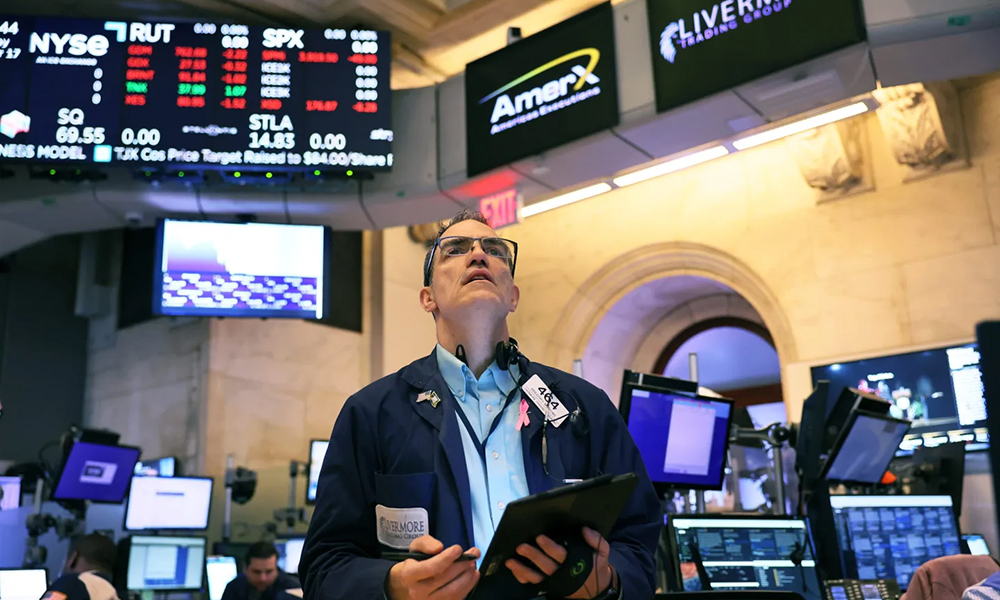
瑞银全球财富管理公司(UBS Global Wealth Management)表示,"通货紧缩"将成为2023年金融界的"年度关键词"。
考虑到6月份通货膨胀率达到9.1%的40年高点,这是一个大胆的选择,但大多数经济学家如今认为,消费价格涨幅已经见顶。
在通货膨胀率超过9%后的几个月里,汽油价格下跌了近40%,房地产市场暴跌,商品价格整体开始降温。
因此,美国上个月的通货膨胀率同比下降至7.1%,尽管这仍远高于美联储2%的目标通胀率,但瑞银全球财富管理公司美洲资产配置主管杰森·德拉霍(Jason Draho)认为,通货膨胀“可能会在2023年上半年持续快速下降”。
"通货紧缩已经发生了。"他在12月16日的研究报告中写道。"未来会出现通货紧缩,这一点毋庸置疑,争论的焦点是未来通货紧缩的严重程度。"
德拉霍说,明年经济学界的主要争论是,如果与目前预期相比,不再持续进行加息,通胀是否会回落到美联储2%的目标,或者通胀是否会在4%左右"触底"。
但他明确表示,选择"通货紧缩"作为2023年的年度关键词(或称WOTY),并不是预测。
他写道:“预测通货紧缩将成为明年最主要的市场故事,并不是预测会出现严重的通货紧缩,到年底通胀将恢复到2%的目标通胀率。但正如美联储收紧金融环境推动了今年整个金融市场的表现一样,潜在的通货紧缩可能在2023年起到同样的作用。如果这都不是金融界年度关键词的秘诀,那就没有什么是了。”
德拉霍继续阐述了选择 "通货紧缩"作为年度关键词的几大关键原因。
首先,他说,美国经济通货紧缩的程度对美联储的政策至关重要。为了给经济降温并抑制通货膨胀,美联储今年已经七次加息。
德拉霍写道:“结构性通缩越严重,美联储就可以越早停止加息并开始降息。”
其次,他认为,过去一年,美联储已成为投资者最重要的变量。利率上升使得风险投资吸引力下降,导致一度高涨的科技股和加密货币价格大幅下跌,但这种情况可能在2023年发生转变。
“美联储从投资者的敌人变成朋友,这是明年值得关注的拐点。”他写道。
再次,德拉霍描述了明年通货紧缩的严重程度将如何决定美国经济是否能实现“软着陆”,即在没有衰退的情况下抑制通货膨胀。
最后,虽然2023年年度关键词的另一个明显选择可能与经济衰退相关,比如“软着陆”或“硬着陆”,但德拉霍说,关于经济衰退的争论实际上是“语义”方面的问题。
“这两种情况都可能导致盈利衰退。”他表示。“然而,大幅通缩与小幅通缩在宏观上存在巨大差异。”(财富中文网)
译者:中慧言-王芳
瑞银全球财富管理公司(UBS Global Wealth Management)表示,"通货紧缩"将成为2023年金融界的"年度关键词"。
考虑到6月份通货膨胀率达到9.1%的40年高点,这是一个大胆的选择,但大多数经济学家如今认为,消费价格涨幅已经见顶。
在通货膨胀率超过9%后的几个月里,汽油价格下跌了近40%,房地产市场暴跌,商品价格整体开始降温。
因此,美国上个月的通货膨胀率同比下降至7.1%,尽管这仍远高于美联储2%的目标通胀率,但瑞银全球财富管理公司美洲资产配置主管杰森·德拉霍(Jason Draho)认为,通货膨胀“可能会在2023年上半年持续快速下降”。
"通货紧缩已经发生了。"他在12月16日的研究报告中写道。"未来会出现通货紧缩,这一点毋庸置疑,争论的焦点是未来通货紧缩的严重程度。"
德拉霍说,明年经济学界的主要争论是,如果与目前预期相比,不再持续进行加息,通胀是否会回落到美联储2%的目标,或者通胀是否会在4%左右"触底"。
但他明确表示,选择"通货紧缩"作为2023年的年度关键词(或称WOTY),并不是预测。
他写道:“预测通货紧缩将成为明年最主要的市场故事,并不是预测会出现严重的通货紧缩,到年底通胀将恢复到2%的目标通胀率。但正如美联储收紧金融环境推动了今年整个金融市场的表现一样,潜在的通货紧缩可能在2023年起到同样的作用。如果这都不是金融界年度关键词的秘诀,那就没有什么是了。”
德拉霍继续阐述了选择 "通货紧缩"作为年度关键词的几大关键原因。
首先,他说,美国经济通货紧缩的程度对美联储的政策至关重要。为了给经济降温并抑制通货膨胀,美联储今年已经七次加息。
德拉霍写道:“结构性通缩越严重,美联储就可以越早停止加息并开始降息。”
其次,他认为,过去一年,美联储已成为投资者最重要的变量。利率上升使得风险投资吸引力下降,导致一度高涨的科技股和加密货币价格大幅下跌,但这种情况可能在2023年发生转变。
“美联储从投资者的敌人变成朋友,这是明年值得关注的拐点。”他写道。
再次,德拉霍描述了明年通货紧缩的严重程度将如何决定美国经济是否能实现“软着陆”,即在没有衰退的情况下抑制通货膨胀。
最后,虽然2023年年度关键词的另一个明显选择可能与经济衰退相关,比如“软着陆”或“硬着陆”,但德拉霍说,关于经济衰退的争论实际上是“语义”方面的问题。
“这两种情况都可能导致盈利衰退。”他表示。“然而,大幅通缩与小幅通缩在宏观上存在巨大差异。”(财富中文网)
译者:中慧言-王芳
“Disinflation” will be the finance world’s “word of the year” in 2023, UBS Global Wealth Management says.
It’s a bold choice considering inflation reached a four-decade high of 9.1% in June, but most economists now believe consumer price increases have since peaked.
In the months since inflation topped 9%, gas prices have dropped nearly 40%, the housing market has tumbled, and prices for goods overall have begun to cool.
As a result, year-over-year inflation fell to 7.1% last month, and although that’s still well above the Federal Reserve’s 2% target rate, Jason Draho, head of asset allocation for the Americas at UBS Global Wealth Management, believes that inflation is “likely to continue falling rapidly in the first part of 2023.”
“Disinflation is already happening,” he wrote in a Dec. 16 research note. “That there will be disinflation is not really in dispute at this point, the debate is over how much disinflation there will actually be.”
The major argument in economics circles next year will be whether inflation will fall back to the Fed’s 2% target without more interest rate hikes than are currently expected, or if inflation will “hit a floor” at around 4%, Draho said.
But he made it clear that choosing “disinflation” as his word of the year, or WOTY, for 2023 isn’t a forecast.
“Predicting that disinflation will be the most dominant market story next year is not a prediction for significant disinflation, with a return to 2% inflation by year-end,” he wrote. “But just as the Fed tightening financial conditions is what drove performance across financial markets this year, potential disinflation could do the same in 2023. If that’s not a recipe for a finance WOTY, then nothing is.”
Draho went on to lay out a few key reasons for selecting “disinflation” as his word of the year.
First, he said that the amount of disinflation in the U.S. economy will be critical for Federal Reserve policy. The Fed has raised interest rates seven times this year in an attempt to cool the economy and tame inflation.
“The more rampant and structural disinflation is, the sooner the Fed can stop hiking rates and start cutting,” Draho wrote.
Second, he argued that the Fed has become the most important variable for investors over the past year. Rising interest rates have made risky investments less attractive, leading to major price declines in once high-flying tech stocks and cryptocurrencies, but that could shift in 2023.
“[A] Fed that goes from investor foe to friend is the inflection point to watch next year,” he wrote.
Third, Draho described how the amount of disinflation next year will determine whether the U.S. economy will be able to achieve a “soft landing”—where inflation is tamed without a recession.
And finally, while the other obvious choice for word of the year in 2023 might be recession-related—like “soft landing” or “hard landing”—Draho said the debate over what a recession might look like is really about “semantics.”
“Both could entail negative earnings growth,” he said. “Whereas there is a big macro difference between a lot versus a little disinflation.”






